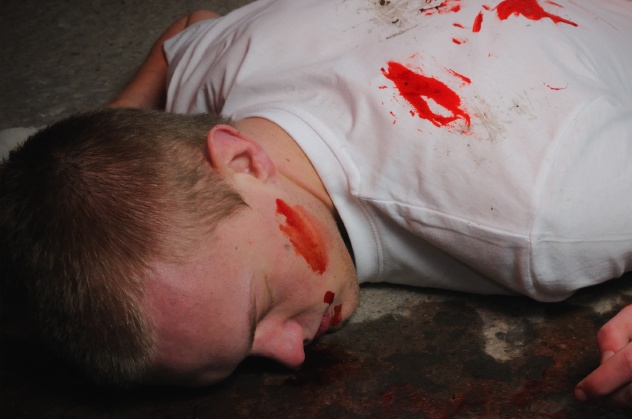 Weird Stuff
Weird Stuff  Weird Stuff
Weird Stuff  Our World
Our World 10 Ways Your Christmas Tree Is More Lit Than You Think
 Movies and TV
Movies and TV The 10 Coolest Stars to Set Sail on The Love Boat
 History
History 10 Things You Didn’t Know About the American National Anthem
 Technology
Technology Top 10 Everyday Tech Buzzwords That Hide a Darker Past
 Humans
Humans 10 Everyday Human Behaviors That Are Actually Survival Instincts
 Animals
Animals 10 Animals That Humiliated and Harmed Historical Leaders
 History
History 10 Most Influential Protests in Modern History
 Creepy
Creepy 10 More Representations of Death from Myth, Legend, and Folktale
 Technology
Technology 10 Scientific Breakthroughs of 2025 That’ll Change Everything
 Weird Stuff
Weird Stuff Ten Bizarre Facts About The Doge Meme
 Our World
Our World 10 Ways Your Christmas Tree Is More Lit Than You Think
 Movies and TV
Movies and TV The 10 Coolest Stars to Set Sail on The Love Boat
Who's Behind Listverse?

Jamie Frater
Head Editor
Jamie founded Listverse due to an insatiable desire to share fascinating, obscure, and bizarre facts. He has been a guest speaker on numerous national radio and television stations and is a five time published author.
More About Us History
History 10 Things You Didn’t Know About the American National Anthem
 Technology
Technology Top 10 Everyday Tech Buzzwords That Hide a Darker Past
 Humans
Humans 10 Everyday Human Behaviors That Are Actually Survival Instincts
 Animals
Animals 10 Animals That Humiliated and Harmed Historical Leaders
 History
History 10 Most Influential Protests in Modern History
 Creepy
Creepy 10 More Representations of Death from Myth, Legend, and Folktale
 Technology
Technology 10 Scientific Breakthroughs of 2025 That’ll Change Everything
10 Shocking Fraternity Hazing Scandals
Fraternities have become one of the most well-known aspects of college life in the United States. They have existed since the 19th century, and members of these fraternities often remain in touch for the rest of their lives. While there are certainly good aspects to fraternities, there are other, darker parts of the culture. For some time, deaths and accidents have occurred due to initiation rituals, more commonly known as hazing. Over the years, these deaths have caused authorities to take notice, change legislation, and sometimes even outright ban fraternities. These are a few of the worst hazing scandals.
10 George Desdunes
While most fraternity hazing rituals involve elder members testing newer members, a particular ritual of Cornell’s Sigma Alpha Epsilon chapter was a reverse of this concept: Younger members would haze older members. In February 2011, George Desdunes and another Cornell sophomore were kidnapped and blindfolded, and their wrists and ankles were bound with duct tape and zip ties. As scary as this sounds in hindsight, it was all in “good fun.” As the evening wore on into the early morning hours, Desdunes and his friend were asked questions about the fraternity and forced to drink a shot of vodka for each question they got wrong.
Judging by the amount of vodka consumed that evening, they must have missed a number of questions. According to Desdunes’s roommate, “The purpose is to tie up the brother and get him drunk.” Desdunes consumed four or five shots of vodka in a very short period of time. He proceeded to vomit into a garbage pail. The two were also fed were Pixy Stix, chocolate powder, strawberry syrup, a bite of a sandwich, and hot sauce. Other unknown substances were given to them, one of which apparently tasted like soap. They continued to drink and vomit. Beer pong was allegedly played, and the kidnappers must have forgotten about their victims, as they left them and went on to other activities before falling asleep. While they claimed that Desdunes was taken care of before they left him, this is doubtful.
The next day, a cleaning person discovered Desdunes unresponsive. His mouth was filled with vomit. Despite the paramedics’ best efforts, nothing could be done. Desdunes was dead; his blood alcohol content (BAC) was 0.35, a lethal level. One of the kidnapper’s lawyers claimed that Desdunes had a history of binge drinking, and he could have stopped the hazing at any time by voicing his distress. All four of the kidnappers were charged with misdemeanor hazing and tampering with evidence. While they were acquitted, the fraternity was fined $12,000.
9 Jack Ivey

Jack Ivey died in one of the most tragic incidents of hazing gone wrong. Like most other hazing rituals, liquor was used in the extreme. Jack Ivey was 23 and a member of Phi Kappa Sigma at the University of Texas at Austin. Several members of his fraternity tricked him into drinking massive amounts of liquor. They then proceeded to abuse him in several humiliating ways.
As far as it can be pieced together, Ivey was dared into a drinking contest with another member. Jack was given rum, while the other member was given water. It’s quite obvious from here what must have happened to the poor boy. After all was said and done, Jack Ivey was found to have a BAC of 0.46. He was then stripped to his underwear and tied to the back of a truck. He was then driven around like that by other fraternity members before being left for dead.
Afterward, Ivey’s family filed a lawsuit against the university and the fraternity. They were eventually awarded a $2 million settlement. The fraternity was punished as well. Alcohol was banned on the premises, and all members were required to perform 50 hours of community service. While Jack Ivey’s parents received some restitution for the suffering caused by the fraternity and their shockingly callous treatment of their son, no settlement will ever replace their son.
8 Samuel Mason

Unlike most incidents of lethal hazings, those involved in the death of Samuel Mason actually got jail time. As usual, Mason’s death involved reckless alcohol consumption. He was under 21, the legal drinking age, when he was given alcohol during his initiation into Tau Kappa Epsilon (TKE). That’s why those responsible were imprisoned.
While most of us would think that the accidental death of Mason would be the major charge, it was actually the aforementioned alcohol charges. Mason was 19 and attending Radford University in Virginia in 2011. The fraternity’s initiation ritual involved Mason having to drink an entire bottle of liquor. Mason did so in an hour, a feat that would be dangerous for even a seasoned drinker. He died from alcohol poisoning after vomiting and passing out. His BAC was 0.48, six times the legal limit.
After the incident, investigations were blocked mainly because of TKE’s code of silence. Very few members talked about what had occurred in order to protect each other from prosecution. The same fraternity chapter had been sanctioned previously by university authorities for giving alcohol to minors, but there were no other inquiries. Eventually, answers were obtained, and seven members of the fraternity were charged in Mason’s death. While the seventh member was eventually cleared of charges, the other six pleaded guilty and were given two years in jail and fined $1,000 each. Five of them had their sentences suspended and served no jail time.
7 Stuart Pierson

To prove that deadly hazing isn’t a recent phenomenon, we go back to 1905. Hazing has been a ritual in most fraternities and organizations for decades. Many deaths were either not investigated due to codes of silence or swept under the rug. One of the first incidents to receive wide recognition was the case of Stuart Pierson, who was attempting to join Delta Kappa Epsilon (DKE) at Kenyon College.
Stuart Pierson’s father had been a member of DKE, so it seemed only natural that Stuart would follow in his father’s footsteps. The 18-year-old freshman had no idea what he was getting himself into. Newbold Pierson, Stuart’s father, wanted to join his son’s initiation, but his train was extremely late. Throughout the night, Stuart worried for his father, so he didn’t sleep at all.
This sleep deprivation would follow him into the coming events, which are quite murky, as the entire story about what happened to Stuart is still not entirely clear. What we do know is that one of the initiation’s traditions was to take pledges out into the dark at night. Stuart was taken into the forest. At 9:41 PM, he was struck by a train and killed. The engineer of the train didn’t see anything, and it wasn’t until they arrived at their next stop that they saw blood on the train. Meanwhile, fraternity members discovered Stuart’s corpse and returned him to the college.
The story made international headlines, and it was believed that Stuart had been tied to the tracks as part of a hazing ritual. The Oregonian called Stuart’s death a “barbarous atrocity,” and Le Petite Parisian said that the accident “exceeds in atrocity the most macabre inventions of Edgar [Allan] Poe.” No evidence was found that Stuart was tied to the tracks. Soon, the witch hunt died down. No one was charged, and it’s widely believed that Stuart had fallen asleep on the tracks.
6 Michael Davis

Michael Davis’s death is considered one of the most brutal hazing deaths in history. Its cruelty and callousness caused national attention. Unlike Stuart Pierson’s death, in which negligence and misfortune was primarily to blame, Davis was tragically murdered because of a deliberately violent hazing ritual. Davis, who was attending Southeast Missouri State University, endured a slow, painful death that he didn’t deserve.
Michael Davis was a pledge for Kappa Alpha Psi (KAP) in 1994. Davis wasn’t a very big guy; he was slightly built and not violent in any way. As part of his initiation, Davis was repeatedly kicked and punched over a long period of time by other members of the fraternity. Finally, after they had their fun, they took Davis to his student apartment, where he later died from massive internal injuries at age 25. The body was so badly bruised that the coroner told his family not to look at him. Other pledges had endured similar treatment, but none as badly as Davis.
After an investigation, seven members of the fraternity were charged with hazing and involuntary manslaughter. All of them were described as very well-liked and without prior criminal records. Because of Davis’s death, the university expelled the KAP chapter from campus. Davis had joined because he thought that KAP would help him later in life and believed that the hazing was good for him. He wrote in his diary: “Hazing is the conditioning of the mind.” The seven fraternity members served short jail sentences, and Davis’s family received a settlement of $1.4 million.
5 Joseph T. Green

Joseph T. Green was a US Navy veteran who died suddenly in 2001 at the age of 25. After serving in the Navy, he decided to attend college at Tennessee State University in Antioch. Soon afterward, he decided to join the Omega Psi Phi (OPP) fraternity. After Green collapsed during his hazing, he was taken to Skyline Medical Hospital, where he later died.
Green was in good physical health, so why did he die so suddenly? After police questioned the members who participated in the hazing, they discovered the full story. Green had asthma, but he mostly had the condition under control. As part of the hazing, he was forced to do extreme physical exercises in the middle of the day on a local high school’s running track. He was forced to run and to continue running until they told him to stop. The extreme heat along with the physical exercise caused Green to collapse from an acute asthma attack.
When paramedics checked his temperature, it was 39.8 degrees Celsius (103.7 °F). He died from hyperthermia after experiencing breathing difficulties and heart problems related to the extreme activity. No criminal charges were filed, but Green’s family filed a $15 million lawsuit, and the OPP chapter was suspended for five years.
4 Van L. Watts

Joseph T. Green wasn’t the only student to die from hazing by Omega Phi Psi at Tennessee State University. In 1983, a junior engineering student named Van L. Watts was found dead after his hazing. After a previous hazing incident, the fraternity had been banned for five years but was readmitted. (Does that sound familiar?) According to the police report, Watts, who was 20 years old, endured a horrifying ordeal.
The original 1983 news report stated that empty bottles of whiskey were found strewn all around the fraternity, showing that huge amounts of alcohol had been consumed the previous night. Watts’s body was tested for alcohol, and it was discovered that his BAC was 0.52, five times above the legal limit. It was estimated that Watts, who weighed 70 kilograms (150 lb), would have had to drink 26 shots of 100-proof liquor to have that BAC, but that was only part of his death. On Watts’s body, bruises were discovered, indicating that he had been hit. It was revealed that as part of the hazing, pledges were “branded” by the other members of the fraternity. In this case, after Watts collapsed from drinking, he was hit with a switch (a strong, flexible piece of wood used for corporal punishment), and his head was shaved.
Watts had a bright future. His high school principal said Watts was “your typical example of what you want your students to be.” No charges were filed, but OPP was banned from campus for 20 years.
3 Chad Meredith
Chad Meredith’s hazing death caused a change in the way that hazing was prosecuted in the state of Florida. Previously, those found guilty of hazing would only receive a misdemeanor on their record. A misdemeanor, while shameful on a legal record, carries very little weight after the initial punishment is served. After Meredith’s death, however, laws were passed in which hazing could carry a felony charge.
Chad Meredith was 18 years old when he died in 2001. He was attending the University of Miami after a high school career in which he played basketball, which he wished to play professionally. He decided to join the Kappa Sigma fraternity. As a pledge, he was forced to participate in a dangerous hazing. Meredith, in the company of the fraternity president and two upper brothers, drank until his BAC was twice the legal limit. He was then told to jump into a nearby lake, which was cold and dark. Jumping into a lake while intoxicated is incredibly dangerous, but Meredith was drunk and did as he was told. The other “brothers” also went into the lake and swam further in. Meredith followed. As he tried to keep up, he grew colder and more fatigued. Too intoxicated to go further, he called for help. No one rescued him. Hours later, the police discovered his lifeless body in the lake.
In 2006, after a lengthy trial, a jury awarded Meredith’s family $14 million, the largest hazing settlement ever given. Governor Jeb Bush signed the Chad Meredith Act, which made hazing a felony offense.
2 Benjamin Klein

Benjamin Klein was not killed due to a hazing ritual; he died because he outed several details of Zeta Beta Tau’s (ZBT) hazing practices. Later, he apparently committed suicide, and many believe that he did so because of issues related directly to the fraternity. Because of his suicide, and what happened to him in the days leading up to it, all Greek fraternities were banned from Alfred University’s campus.
In 2002, at a regional fraternity convention in a Syracuse hotel, 21-year-old Benjamin Klein was restrained and attacked by four other ZBT members. Their reasoning, it seems, was because he was drunk, swore at senior members, and revealed “certain initiation practices.” Klein’s attackers tied him up with duct tape in his hotel room, hit him in the head with a boot, placed him in the bathtub, turned the shower on while he was still tied up, beat him more, and continued to do so during their drive back to Alfred University. Three days after the incident, Klein overdosed on prescription drugs and jumped into a creek behind the fraternity house, where the police discovered him. His body was covered in cuts and bruises, which is how they learned of his beating days earlier.
It was determined that the beating caused him to commit suicide, although the attackers’ attorneys argued that Klein had a history of emotional problems and drug issues. Four of his attackers made plea deals, while Adam Shain, his fifth attacker, was found guilty of assault and hazing. He was given 60 days in jail, three years of probation, and anger management counseling. Because of the severity of the incident and other incidents on campus related to Greek life, all fraternities were banned by Alfred University in 2002.
1 Matthew Carrington
Much like Chad Meredith, Matthew Carrington’s death caused California to change hazing legislation to allow for felony charges. Even today, he is still honored by Chico University, where he attended. His death was unusual and could have been avoided if he had received help in time. Members of the Chi Tau fraternity, rather than acknowledge obvious signs of distress in Carrington, allowed him to die.
The initiation rituals for Chi Tau’s pledges were so infamous that the period of time in which they occurred was known as “Hell Week.” It involved extreme physical exercises that pushed pledges to the limit of their abilities. In the basement of the frat house, Carrington was forced to do jumping jacks and calisthenics while answering questions about the fraternity. For every question he got wrong, he was forced to either do push-ups or drink water from a 5-gallon jug while a fan blew on him. After drinking huge amounts of water from the jug, Carrington was put into a sleeping bag. When he was checked later, he was no longer breathing. By the time help arrived, he was dead.
The cause of death was hyponatremia, or water intoxication, which is caused when excessive water intakes creates a sodium imbalance, causing cells to swell. Those involved with Carrington’s death were charged with misdemeanors and felony manslaughter. After another hazing death and being called a party school by Playboy, Chico University banned fraternities. In 2006, California passed Matt’s Law, which created the charge of felony hazing.
Gordon Gora is a struggling author who is desperately trying to make it. He is working on several projects but until he finishes one, he will write for listverse for his bread and butter. You can write him at [email protected].








